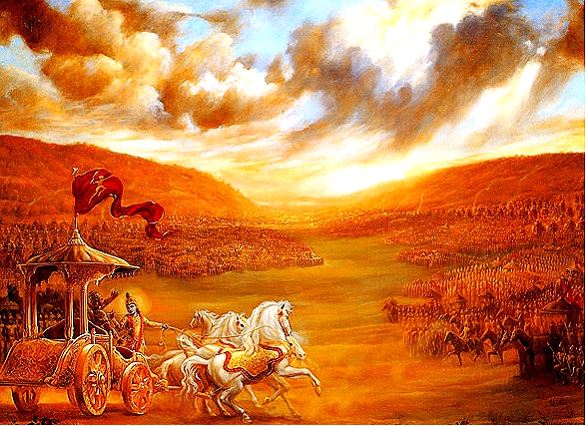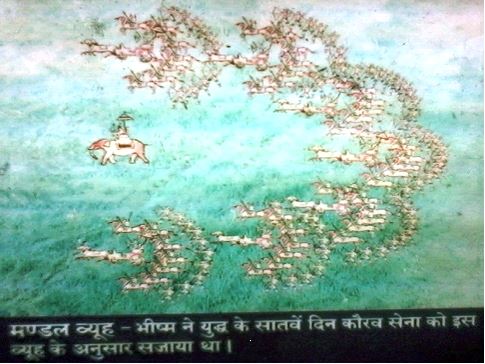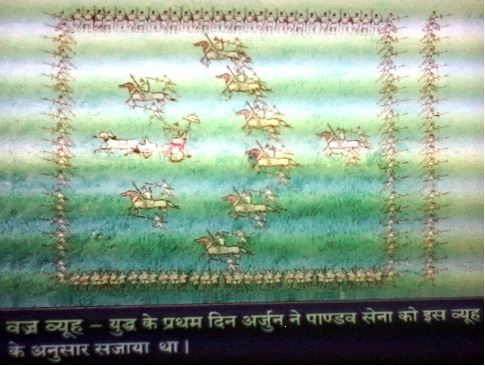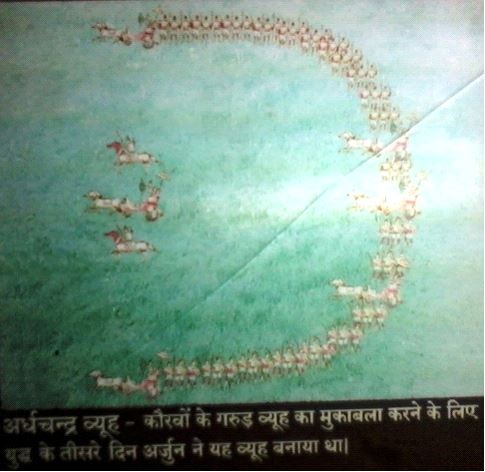
Different military formations of Mahabharata and ancient indian wars
Vyuha, meaning “Cover or veil” technically means “arranging troops of army in proper order for battle” so as to separate, divide, disarrange, terrorize and dispose the army-men of the enemy.
Word Vyuha is also used to refer the supreme power of lord Vishnu. In Usha Upanishad, a sloka on vyuha states
ेष्रकेन्नषूप यम सूर्य प्राजापत्य व्यूह रश्मिन्समूह |
तेजो यत्ते रूपं कल्याणतमं तत्ते पश्यामि योऽसावसौ पुरुषः सोऽहमस्मि ||
"O Sun, sole traveler of the Heavens, controller of all, Surya, son ofPrajapati, remove thy rays and gather up the burning light. I behold thy glorious form; I am he, the Purusha within thee."
In case of military affairs, vyuha means re-arranging the position of different warriors and use of weapons as per the situation of battle. In spiritual terms, Vyuha means resetting the content of consciousness through yogamaya where each formation hides another formation. Our human body made of five elements of matter, moves from visible layer through refined invisible layers in search of god situated within.
Different types of vyuhas (Military Formations) in war
Mahabharata is filled with references to many formations, some small in size with only hundreds of warriors while some extremely huge in size with thousands of warriors.

Chakra-Vyuha and Vajra-Vyuha is said to be the most powerful of all formations. Some of the military formations mentioned in Mahabharata are
1. Chakra vyuha - formation of concentric circles in layers
2. Chakra Shakata vyuha - formation of a cart wheel
3. Mandala vyuha - circular formation ( dont know how this is different from the above)
4. Vajra vyuha (in the shape of the thunderbolt)
5. Garuda vyuha (Garuda - The Mighty Bird)
6. Krauncha vyuha (Krauncha is bird with a sharp pointed beak)
7. Ardha Chandraakara vyuha (crescent shape)
8. Padma vyuha (formation of a blooming lotus)
9. Makara vyuha (crocodile-shaped)
10. Urmi vuyha - formation resembling ocean's waves
11. Sarvatobhadra vyuha - meaning "safe on all sides" - seems to have been a kind of square array in which the troops faced all the points of the compass (as per KMG interpretation)
12. Suchimukha vyuha (formation in the shape of a needle)
13. Deva & Asura vyuha have been mentioned as well (cant interpret how they were)
Apart from the above, there are many other military formations described in different literary scriptures.
ChakraVyuha
Chakravyuh can be termed as the most brilliant military tactic of all times. Chakra means “spinning wheel” and “vyuha” means formation. Hence, chakravyuha means the puzzled arrangement of soldiers that keeps moving in the form of a spinning wheel. Rotation of soldiers is very similar to helix of a screw commonly seen in watches.
The most noted chakravyuha in Mahabharata war was arranged by Drona, one of the smartest military strategists of his era. The objective was to take yudhisthira, the leader of the Pandavas, as prisoner of war.
Detailed explanation on chakrvayuh can be found in below link
<https://mallstuffs.com/chakr>
Chakra Shakata Vyuha
Chakra Shakata Vyuha is a defensive formation that was used by Drona on 14th day of Mahabharata war to protect Jayadratha. In this formation, king or any VIP minister that needs to be protected from the enemy is placed at the centre of the formation and is surrounded by circular formation of cavalry, elephants and infantry. Cavalry formed the inner portion of the formation while elephants guarded the outer side of the formation.

Mandala Vyuha (Mandala - Circle)
Bhisma chose Mandala Vyuha formation on seventh day of the war. Mandala Vyuha is a defensive formation that is very difficult to penetrate for the opponent army. Commander-in-chief, situated at the centre of the formation, usually leads the army and is surrounded by several small groups of army-men, each group lead by a Maharathi (One who can defeat thousands of warriors with a single strike).

Sarvatobhadra Vyuha (Sarvatobhadra - Safe from all sides)
“Sarvatobhadra Vyuha”, meaning “safe from all sides” was opted by Kaurava on 9th day of the war. This formation was chosen to protect Bhisma from the clutches of pandavas. Bhisma at the front was guarded by Kripa, Kritaverma, Shakuni, Trigartas, Kamboja, Jayadratha and sons of Dhritarastra. Pandavas arranged a constellation shaped formation in which the five pandavas and their sons lead from the front. Shikhandi, Chekitan and Ghatotkacha held defensive positions in the formation. Abhimanyu, Kekaya brothers and Drupada guarded the rear portion of the formation
Vajra Vyuha
Pandava chose “Vajra Vyuha” to counter Mandala Vyuha formation. This formation was also used on first day of the war. In this formation, all maha-rathis are situated at the centre of the squared formation and are surrounded by infantry from all sides. Dhristyadhumna lead the formation and was followed by the five Pandavas.

Garuda Vyuha(Garuda - The Mighty Bird)
This formation was arranged by Pandava army commander ‘Bhishma’ on second day of Mahabharata. Bhisma himself got positioned at the beak of the formation while Kripa and Ashvatthama formed the head of the formation. Drona and Kritavarna were its eyes. The Trigartas along with the Jayadratha and army-mens formed the neck portion of the formation. Duryodhana, his brothers, Vinda and Anuvinda formed the body of the formation whereas King of Kashala & Brihadbala formed the tail of the formation.
Krauncha vyuha(Krauncha - a Bird)
Krauncha vyuha, a very offensive formation, was generally attempted to induce fear in the opponent army. Krauncha vyuha was employed by pandava army on the second day of Mahabharata. King ‘kuntibhoja’ was placed at the eye of the formation whereas king Drupada was positioned at the head of the formation. Neck of the bird was taken up by the soldiers of satyaki. Bhima and Dhristadhymna formed the wings of the formation that were guarded by sons of Draupadi and Satyaki.

This view was also arranged by bhisma in which Bhurishrava and Salva guarded the wings and Somdatta, Ashwatthama, Kripa & Kritavarma took different crucial positions in the formation.
Ardha Chakra Vyuha(Ardha Chandra - Half Cresent)
Arjuna arranged this formation in consultation with commander of Pandava army ‘Dhristadhymna’ on the 12th day of the war. On the extreme right of the formation was the powerful bhima with satyaki and five sons of draupadi while Abhimanyu took the extreme left position. Yudhisthira was placed at the centre of the formation. Drupada and virata lead the army from the front. They were assisted by Neel, Dhristaketu, Dhristadhymna and Shikandi. At the tip of the formation was arjuna on his chariot with lord Krishna.

Padma Vyuha
Very Similar to Chakra-Vyuha, this is a multi-tiered defensive formation in the form of a blooming lotus when viewed from above. Only a handful of warriors knew the technique of breaching this formation. Historians claims Chakra-vyuha and padma- vyuha to be one and the same and often used these formations interchangeably.
Makara Vyuha ( Makara - Crocodile)
Kaurava Commander ‘Bhisma’ arranged his army in this formation on fifth day of the war. To counterattack this formation, Arjuna, Yudhisthira and Dhristadhyumna opted for hawk formation of their army. All main warriors on both sides were assigned special places and responsibilities in the formation. Pandava preferred “Makara vyuha” on sixth day of the war but later opted out to choose Krauncha Vyuha.

Oormi Vyuha & Sringataka Vyuha
“Oormi Vyuha” formation was arranged by kauravas on eight day of the war. In this formation, army is arranged on either side like the waves of the sea. Arjuna chose
“Sringataka Vyuha” to counter-attack this formation
Asura Vyuha and Deva Vyuha
Kaurava army chose “Asura Vyuha” on 10th day of the war and pandava chose “Deva Vyuha” formation to counter it. Shikhandi lead the formation. Bhima and arjuna protected his both sides. Shikhandi was followed by Satyaki, Dhristadhyuma, abhimanyu and sons of Draupadi. Virata and Drupada lead the rest of the army. This formation was arranged to have a single point aim on Bhishma and at the end, they were successful in killing bhisma.
Summary:
Military formation was very important in ancient times as the soldiers would be clueless on how to fight if not properly trained on different situations of war. Vyuha gave the much-needed understanding, command, guidance and direction on tackling of the enemy warriors as per the demands of the wars. In coming articles, I will discuss more on ancient military science, divine weapons and highly advanced military technologies.
Note: Images used on this website
are either a production of Bhaktivedanta Book Trust(https://www.krishna.com), Iskcon
Foundation or were found in google search under "Free to use and share". If any
of the images presented here violates copyright issues or infringes anyone copyright
or are not under "Fair use", then please bring it to our notice. Read
Disclaimer for more.
Share this to your friends. One of your friend is
waiting for your share.
Related Articles
Different military formations of Mahabharata and ancient indian wars
Chakravyuha-The most deadliest and brilliant military formation
Mindblowing vimanas or airplanes of mahabharata
How many Gods in Hinduism
Why we cannot see god
Cheating and Deception by lord krishna
Bhagavad Gita Poetic Translation-Text 5
Bhagavad Gita Poetic Translation-Text 4
Bhagavad Gita Poetic Translation-Text 3
Post Comment